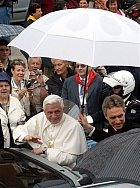John Paul Put on Fast Track for Sainthood | May 13, 2005
5-13-2005
By Daniela Petroff
Associated Press
VATICAN CITY Pope Benedict XVI put his predecessor on the fast track for sainthood Friday and appointed San Francisco Archbishop William Levada as his successor as guardian of church doctrine, the highest Vatican office ever held by an American.

The pope's decision to authorize the start of the process for sainthood for Pope John Paul II overrode the usual five-year waiting period following the death of a candidate before beatification procedures can begin. The only other time the waiting period was waived was for Mother Teresa. The process was begun a year after her death.
Benedict made the announcement in Latin during a meeting at the Basilica of St. John Lateran with the Roman clergy. Friday is the anniversary of an 1981 assassination attempt on John Paul in St. Peter's Square at the hands of a Turkish gunman.
In his other announcement, Benedict tapped his old friend Levada, a 68-year-old conservative theologian, as prefect for the Congregation of the Doctrine of the Faith, filling the job that he had held for nearly 24 years before being named pope last month.
The position is one of the most powerful at the Vatican, responsible for ensuring the faithful follow church doctrine and punishing those who don't. During his term as prefect, then Cardinal Joseph Ratzinger wielded enormous power in shaping church policy, silencing dissident theologians and signing off on virtually every document that had to do with doctrine.
It was likely that Levada would maintain the Vatican's uncompromising opposition to abortion, euthanasia, ordaining women, homosexuality and lifting the celibacy requirement for priests.
Levada has voiced opposition to same-sex marriages and said priests should ask bishops for guidance on whether to refuse a Catholic politician communion if the politician supports abortion rights. He also has been involved in efforts aimed at Episcopal-Roman Catholic dialogue in the United States.
In anticipation of the appointment, the Rev. Jim Bretzke, co-chair of the University of San Francisco's theology department, described Levada as intelligent, careful and fair. "He has all the right credentials," Bretzke said. "The conservatives respect him and even the liberals respect him."
In tapping an American, Benedict has put someone in charge of his old office who is deeply familiar with the clergy sexual abuse scandal in the U.S. church. After the scandal erupted in 2002, John Paul decided that the issue should be handled by the doctrinal office.
A major victims' group in the United States bitterly complained about Levada's appointment, saying it was "an insensitive and unwise decision."
"Regarding abuse in the San Francisco archdiocese, Levada has been slow to act, harsh to victims and committed to secrecy," said a statement from The Survivors Network of Those Abused by Priests.
About 160 civil sexual abuse cases have been filed against eight northern California diocese, including San Francisco. Only a handful have gone to trial.
Levada has served as archbishop of San Francisco since 1995; before that, he was archbishop of another largely liberal American city, Portland, Ore.
The announcement about John Paul II opens the way for the possible beatification and canonization of John Paul, following an investigation into the late pope's life and approval of miracles attributed to him. One miracle is required for John Paul to be beatified, a second one for him to be declared a saint.
Calls from faithful for John Paul to be declared a saint began immediately after his death on April 2. At his funeral Mass, pilgrims chanted "Santo Santo!" and held up banners saying "Santo Subito" ("Sainthood Now").
Benedict's announcement drew a standing ovation from the Roman priests.
He read a letter in which the official who heads the Vatican's Congregation for the Causes of Saints, Cardinal Jose Saraiva Martins, announced that Benedict himself had waived the five-year waiting period for John Paul's possible sainthood cause to begin.
"And now I have a very joyous piece of news for you," Benedict said in Italian before reading the letter, signed May 9.
Benedict, who had been seated, stood up to join the clergy in applauding the major tribute to his predecessor.
John Paul himself lifted the five-year waiting period for the beatification procedures to begin for Mother Teresa, the nun who dedicated her life to caring for India's poorest people. He launched the beatification process a year after her death in 1997. She was beatified in October 2003.
Vatican officials said Benedict's announcement gives no time element for John Paul's possible beatification and does not do away with requirements including the investigation of the late pope's life and the approval of a miracle.
Monsignor Gianfranco Bella, the official who is responsible for actually starting John Paul's beatification cause, said in an interview Friday that he hoped to start gathering documents and contact witnesses as soon as possible.
"But things have to be done well. They can't be rushed through," said Bella.
He called Benedict's announcement "wonderful," and suggested approving a miracle wouldn't prove too difficult.
"Certainly he had many gifts, and touched so many people," he said. "Even the conversion of one person is a miracle."
Following John Paul's death, Italian newspapers were rife with reports of alleged miracles attributed to him. But the reports stemmed from inexplicable cures that occurred while John Paul was still alive, while according to Vatican procedures, a miracle has to have occurred after John Paul's death for it to be considered in the saint-making process.
The Rev. Peter Gumpel, who is leading the beatification cause for another pope, Pius XII, said Friday that it would still be several years before John Paul could be beatified.
He noted that first all the documents and personal writings of the late pope will have to be gathered, witnesses around the world will have to testify before church tribunals, vast volumes of material will have to be prepared and submitted to panels of historians, theologians, bishops and cardinals for consideration.
Then a miracle attributed to John Paul's intercession must be confirmed.
Beatification is the first step toward canonization. It allows the candidate to be called "Blessed" and honored locally or in a limited way in the liturgy. Canonization is an infallible declaration by the pope that a person who was virtuous to a heroic degree in life is now in heaven and worthy of honor and veneration by all the faithful.
In Wadowice, Poland, where John Paul II was born Karol Wojtyla the news was received with joy.
"I am so happy the new pope did not wait, especially since for me personally John Paul II was a saint even during his lifetime," 47-year-old Jolanta Radon said. "I have my own testimony. … During my last pilgrimage to Rome I had a sick leg and I returned with a healed one. I am absolutely sure I owe it to him."
Associated Press Writer Nicole WInfield contributed to this story from Vatican City.
Posted by admin at May 13, 2005 01:38 PM



